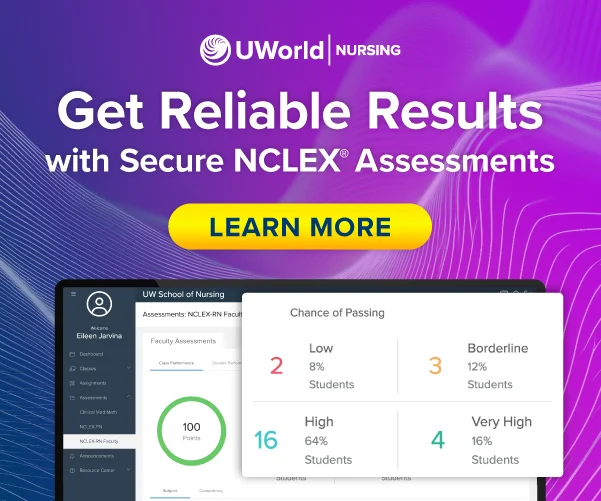As a nurse educator, your ability to interpret data directly impacts how well your students perform on the NCLEX®. UWorld’s dual experience Learning Platform gives you access to powerful analytics that reflect student readiness and offer actionable insights. But understanding how to interpret these metrics—scores, percentiles, performance levels—can help you pinpoint struggling learners, guide remediation, and ultimately raise pass rates.
This article breaks down each data point in UWorld’s Self-Study QBank, Self-Assessments, CATs, and Faculty Assessments—so you can support your students when they need it most.
Understanding Self-Study QBank Performance: What Your Learners' Scores and Percentiles Tell You
When you adopt our NCLEX educator resources, your students receive flexible, focused self-study tools through our dual experience platform. These tools build confidence, reinforce understanding, and support them until they take the NCLEX. The Self-Study QBank is the student-facing extension of UWorld’s Learning Platform, designed to complement faculty-led instruction with personalized, data-driven practice.
As an educator, you can assign UWorld content for lectures, remediation, or homework, while also choosing to activate the Self-Study QBank. This allows students to continue working through rigorous, exam-style questions on their own—reinforcing concepts outside the classroom and even after graduation. By giving students access to the Self-Study QBank, you’re extending your impact and ensuring they’re continuously building readiness throughout their NCLEX journey.
Once students are active in the Self-Study QBank, you gain visibility into their usage and performance through robust analytics, including individual and cohort-level progress dashboards.
Self-Study QBank Median Scores
- NCLEX-RN: 70%
- NCLEX-PN: 64%
How to Interpret Scores
- Students at or above the median are typically progressing on track.
- Those scoring below the median may need targeted remediation, particularly in weaker content areas.
Using Percentile Rank
- At or above the 50th percentile: Suggests higher readiness and a more substantial likelihood of first-time NCLEX success.
- Below the 50th percentile: Identifies at-risk students who may benefit from early interventions.
Tip: These metrics are accessible in your faculty dashboard, making it easy to group students by performance level and personalize support before they fall behind.
CAT Exams: Simulate the NCLEX Experience and Track Endurance
UWorld’s Adaptive Practice Tests (CATs) mimic the NCLEX Computerized Adaptive Testing environment. These tests dynamically adjust difficulty based on the student’s responses, helping to simulate both the pressure and pacing of the live exam.
CAT Exam Format
- Minimum 85 questions, maximum 150
- 5-hour limit
- Available only when students have 150+ unused or omitted QBank questions
Difficulty Level Interpretation
- A score of ~1.05 means the student is “On Track.”
- Scores below this threshold may reflect challenges in content mastery or critical thinking.
Faculty Guidance
Suggest that students take CATs every few weeks before the NCLEX to build test-day stamina, sharpen time management, and reduce test anxiety.
Self-Assessment Tests: Faculty-Controlled Tools for Measuring and Reinforcing Readiness
UWorld’s Self-Assessment Tests are timed, NCLEX-style practice exams that provide critical insights into student readiness. These tests are not automatically available to students—they must be released by faculty, giving you complete control over when and how they are used.
Key Features
- 100 timed questions
- Aligned with the 2023 NCSBN Test Plan
- Includes 3 NGN case studies and 3 NGN standalone items
- Provides a percentile rank
- Includes detailed rationales for each question to guide remediation and support deeper understanding
Performance Levels
- Very High – Strong readiness.
- High – Solid preparation.
- Borderline – Needs improvement.
- Low – At risk.
How to Use Self-Assessments Strategically
Educators commonly deploy these assessments in two key phases:
- During the term: Use self-assessments at strategic points to track progress and improve students’ comfort with NCLEX pacing and item types.
- Post-graduation: Release remaining assessments after program completion so graduates can access full-length, timed practice tests in their final prep weeks.
Each completed assessment provides a performance snapshot and detailed rationales that support targeted remediation. This makes it easier for students to understand their mistakes and focus future study time where it matters most.
Predictive Value
Students who achieve a “High” or “Very High” result with an average score of 70% or above are 99% likely to pass the NCLEX-RN, based on UWorld’s latest data.
Faculty Assessments: High-Yield Tools for Measuring Progress
UWorld’s Faculty Assessments are exclusive, high-quality tools that allow you to evaluate student knowledge and progress before reaching the NCLEX.
What Makes These Assessments Unique
- Each test includes 115 items not found in the QBank or Self-Assessments.
- Reflects the latest NCLEX-RN Test Plan
- No rationales, mimicking live exam pressure
- Ideal for cohort benchmarking
Recommended Use
- Assessment 1 (Beginning of Term): Establish a performance baseline
- Assessment 2 (Later in Term): Measure growth and finalize targeted study plans
Pro Tip: Use these tools to identify at-risk students early and customize remediation long before they enter their final prep window.
Actionable Steps: How Faculty Can Leverage UWorld Data Effectively
To get the most out of UWorld’s Learning Platform, educators should review data regularly and build workflows that link analytics to action.
- Monitor Student Performance
- Track question usage and completion rates.
- View median scores and percentile trends.
- Drill down by category and NGN item types.
- Identify At-Risk Students Early
- Focus on those scoring below the median.
- Prioritize those under the 50th percentile.
- Use this data for intervention triggers.
- Customize Support
- Assign homework based on weak categories.
- Encourage QBank review session.s
- Use lecture videos and rationales as instructional supplements.
- Reinforce Consistent Practice
- Promote self-study throughout the term, not just before the exam.
- Regular CATs are recommended to build retention and test readiness.
- Foster a Growth Mindset in Students
- Emphasize improvement over perfection.
- Use UWorld data as a coaching tool, not just an evaluation metric
- Celebrate steady progress and effort.
Use the dashboard to:
Conclusion: Supporting Student Success Starts with Understanding the Data
When used intentionally, UWorld’s NCLEX performance metrics become a powerful tool for academic success. Every score tells a story, from diagnostic insights in QBank to predictive trends in Self-Assessments and CATs. And as an educator, your ability to interpret that story is what enables your students to succeed.
Activate the right tools. Monitor what matters. And help more students pass on their first attempt.









